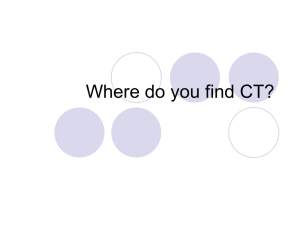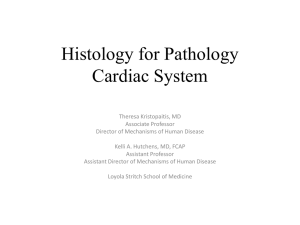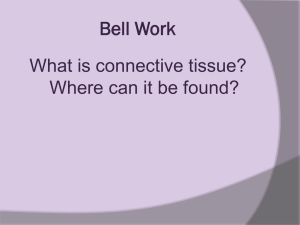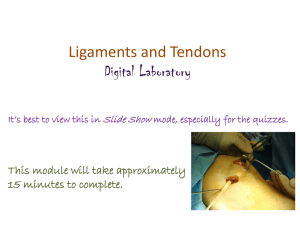Connective Tissue
advertisement
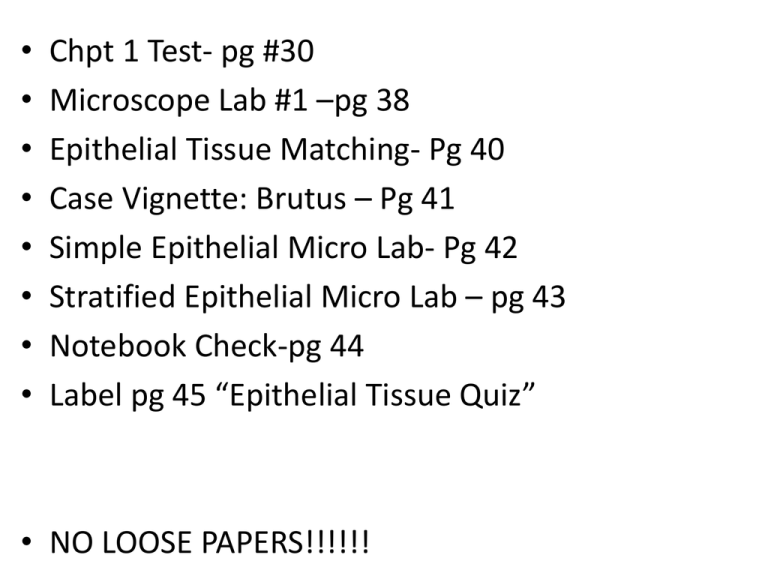
• • • • • • • • Chpt 1 Test- pg #30 Microscope Lab #1 –pg 38 Epithelial Tissue Matching- Pg 40 Case Vignette: Brutus – Pg 41 Simple Epithelial Micro Lab- Pg 42 Stratified Epithelial Micro Lab – pg 43 Notebook Check-pg 44 Label pg 45 “Epithelial Tissue Quiz” • NO LOOSE PAPERS!!!!!! Sponge: Set up Cornell Notes on pg. 47 Topic: Ch. 5 Connective Tissue Essential Question: Describe the general characteristics and functions of Connective tissue. Make a tree map of the three major cell types (on top of pg 46) Don’t forget to add it to your T.O.Contents! Ch.Ions, 5 Connective Tissue 2.1 Atoms, and Molecules Describe the general characteristics and functions of Connective tissue. Make a tree map of the three major cell types Connective Tissues: Comprise much of the body and are the most abundant type of tissue Bind structures provide support and protection fill spaces store fat produce blood cells protect against infection help repair tissue damage * Farther apart than epithelial tissue • C.T. has an extracellular matrix between tissue cells. This matrix consists of fibers and a ground substance whose consistency varies from fluid to semisolid to solid • Can usually divide and in most cases have a good blood supply and are well nourished • Bone/cartilage- rigid • Loose C.T. such as areolar, adipose, and dense C.T.flexible Connective Tissue: Major Cell Types • The fibroblast is the most common kind of fixed cell in CT. – Produce fibers by secreting protein. Stay in C.T. for extended periods of time Macrophages originate as white blood cells. Usually attached to fibers, can detach and move. Scavenger cells. Mast cells are large and widely distributed. Located near blood vessels. Release heparin to prevent blood clotting and histamine to promote reactions to asthma and hay fever. 5.1 Clinical Application Questions • What did scientists find when they looked beyond the collagens in the matrix? • What is the basement membrane composed of? • What happens if the balance of the components of the ECM are off? • Name and explain one of the three diseases that can result. Sponge: Set up Cornell Notes on pg. 49 Topic: Ch. 5 Connective Tissue Essential Question: 1. Differentiate between loose connective tissue and dense tissue. 2. Distinguish between reticular and elastic connective tissue. Don’t forget to add it to your T.O.Contents! Ch. 5 Categories of Connective 2.1 Atoms, Ions, and Molecules Tissue 1. Differentiate between loose connective tissue and dense tissue. 2. Distinguish between reticular and elastic connective tissue. Connective Tissue: Fibers 1. Collagenous fibers are thick strands of collagen, which is the major structural protein of the body. Appear white. flexible, can resist force Ex: ligaments and tendons 2. Elastic fibers are bundles of microfibrils embedded in elastin (a protein). Appear yellow. Can be stretched and deformed and will resume their shape Weaker than collagenous fibers but more elastic. Found in vocal cords and air passages. (Where elasticity is needed). Categories of Connective Tissue • Loose connective tissue (areolar) forms delicate, thin membranes throughout the body. Cells are mainly widely scattered fibroblasts separated by a gel-like ground substance that contains many collagenous and elastic fibers. Binds skin to underlying organs and fills spaces between muscles. Also beneath epithelium. Figure 05.18 Figure 05.18a Loose (areolar) Connective Tissue • Adipose (fat) tissue Certain cells within CT store fat within their cytoplasm. Cushions joints and some organs. Insulates beneath the skin. Lies beneath the skin, between muscles, around the kidneys, in the abdomen, and around the heart. Figure 05.19 Figure 05.19a Adipose (fat) Connective Tissue • Reticular CT is composed of thin, collagenous fibers. Supports the walls of the liver, spleen, and lymphatic organs. Figure 05.20 Figure 05.20b Figure 05.20a Reticular Connective Tissue • Dense CT consists of closely packed, thick, collagenous fibers that can withstand pulling forces. Blood supply poor Make up Tendons and ligaments Figure 05.21 Dense Connective Tissue • Elastic CT consists mainly of yellow, elastic fibers. Found in attachments between vertebrae and within the walls of the heart, larger arteries, and the larger airways. Figure 05.22 Figure 05.22b Elastic Connective Tissue • Cartilage is a rigid connective tissue. Largely composed of collagenous fibers in a gel-like ground substance. Support, frameworks, attachments, protects underlying tissue, forms structural models for many developing bones. Cartilage cells (chondrocytes) occupy chambers called lucunae. Cartilage lacks a direct blood supply. Connective Tissue Categories • Hyaline cartilage is the most common type of cartilage. Ends of bones, in the nose, and in respiratory passages. An embryo’s skeleton begin as hyaline cartilage “models” that bone replaces. Connective Tissue Categories • Elastic cartilage is very flexible. Contains many elastic fibers. Ears and parts of the larynx. Connective Tissue Categories • Fibrocartilage is very tough. Contains many collagenous fibers. Acts as a shock absorber. Intervertebral disks. Connective Tissue Categories • Bone is the most rigid connective tissue. Hardness is due to mineral salts (calcium phosphate and calcium carbonate). Also contains a large amount of collagen for toughness. Bone supports, forms blood cells, and protects. Bone matrix is deposited by osteocytes (bone cells), which form concentric patterns called an osteon. Connective Tissue Categories • Blood is composed of cells suspended in a fluid called blood plasma. Cells are red blood cells, white blood cells, and cellular fragments called platelets. RBCs transport gases. WBCs fight infection. Platelets are involved in blood clotting. Connective Tissues General characteristics • most abundant tissue type • many functions • bind structures • provide support and protection • serve as frameworks • fill spaces • store fat • produce blood cells • protect against infections • help repair tissue damage • have a matrix • have varying degrees of vascularity • have cells that usually divide 38 Connective Tissue Major Cell Types Fibroblasts • fixed cell • most common cell • large, star-shaped • produce fibers Macrophages • wandering cell • phagocytic • important in injury or infection Mast cells • fixed cell • release heparin • release histamine 39 Connective Tissue Fibers Collagenous fibers • thick • composed of collagen • great tensile strength • abundant in dense CT • hold structures together • tendons, ligaments Reticular fibers • very thin collagenous fibers • highly branched • form supportive networks Elastic fibers • bundles of microfibrils embedded in elastin • fibers branch • elastic • vocal cords, air passages 40 Connective Tissues Connective tissue proper • loose connective tissue • adipose tissue • reticular connective tissue • dense connective tissue • elastic connective tissue Specialized connective tissue • cartilage • bone • blood 41 Connective Tissues Loose connective tissue • mainly fibroblasts • fluid to gel-like matrix • collagenous fibers • elastic fibers • bind skin to structures • beneath most epithelia • blood vessels nourish nearby epithelial cells • between muscles Adipose tissue • adipocytes • cushions • insulates • store fats • beneath skin • behind eyeballs • around kidneys and heart 42 Connective Tissues Reticular connective tissue • composed of reticular fibers • supports internal organ walls • walls of liver, spleen, lymphatic organs Dense connective tissue • packed collagenous fibers • elastic fibers • few fibroblasts • bind body parts together • tendons, ligaments, dermis • poor blood supply 43 Connective Tissues Elastic connective tissue • abundant in elastic fibers • some collagenous fibers • fibroblasts • attachments between bones • walls of large arteries, airways, heart Bone (Osseous Tissue) • solid matrix • supports • protects • forms blood cells • attachment for muscles • skeleton • osteocytes in lacunae 44 Connective Tissues Hyaline cartilage Cartilage • rigid matrix • chondrocytes in lacunae • poor blood supply • three types • hyaline • elastic • fibrocartilage • most abundant • ends of bones • nose, respiratory passages • embryonic skeleton Elastic cartilage • flexible • external ear, larynx Fibrocartilage • very tough • shock absorber • intervertebral discs • pads of knee and pelvic girdle 45 Connective Tissues Three types of cartilage Hyaline Cartilage Elastic Cartilage Fibrocartilage 46 Connective Tissues Blood • fluid matrix called plasma • red blood cells • white blood cells • platelets • transports • defends • involved in clotting • throughout body in blood vessels • heart 47




